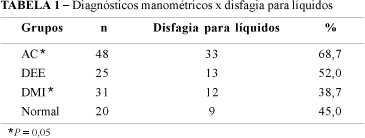Background - Dysphagia is one of principal symptoms of esophageal disorders and its caracterization is important for diagnosis and management of patients. Anamnesis is useful for differenciating organic and functional dysphagia, but data are lacking about dysphagia characterization among different motor disorders. Objectives - To evaluate if it is possible the distinction among esophageal motor disorders according to their manometric diagnosis, based on dysphagia characteristics. Patients and Methods - Dysphagia characteristics (relation with bolus, frequency and localization) of 133 patients submitted to esophageal manometry were reviewed and analysed. All patients had barium swallow studies and/or endoscopy in order to exclude organic lesions. Results - Esophageal manometry was abnormal in 85% of the patients. Characteristics of dysphagia were compared among groups of patients with achalasia, esophageal spastic disorders, non-specific esophageal motor disorders and with normal test. The precise distinction among groups based solely on characteristics of dysphagia was not possible, however some aspects could point to one or another group. In achalasia patients, dysphagia for both solid food and liquids, constant and felt in substernal area, was more frequent in relation to every other group. Intermitent dysphagia was more frequent in patients with spastic disorders. Characteristics of dysphagia in patients with non-specific esophageal motor disorders were similar to those observed in the group with normal test, frequently referred in the neck. Conclusion - Characteristics of dysphagia were ancillary to presume the diagnosis of these motor disturbances, however esophageal manometry is necessary for the correct diagnosis in patients with functional dysphagia.
Esophageal motility disorders; Deglutition disorders




